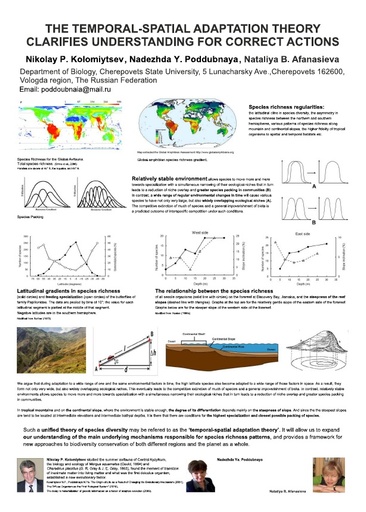pdf The temporal-spatial adaptation theory clarifies understanding for correct actions Popular
2130 downloads

Nadezhda Poddubnaya
Cherepovets State University
Nikolay P. Kolomiytsev and Nataliya B. Afanasieva Department of Biology, Cherepovets State University, Cherepovets, The Russian Federation
 At high latitudes various species living there are forced to adapt to a wide range of seasonal variations in one and the same abiotic and associated biotic variables. As a result, they have not only very wide (Dobzhansky, 1950; Klopfer, 1959), but also widely overlapping ecological niches (Letcher and Harvey, 1994). Since in most cases the high latitude species are not able to avoid interspecific competition or weaken it through competitive divergence because their environment lacks the habitats or niches where interspecific competition is weak, and into which competing species could retreat and become established, the competition at high latitudes often results in ‘competitive exclusion’ (Gause, 1934). The high seasonal and inter-annual environmental variability periodically makes interspecific competition especially keen. Therefore, only a very few, the most robust and adapted species have been able to survive in such harsh ecosystems, and the species diversity of this zone has undergone a strong reduction (Huston, 1979; Letcher and Harvey, 1994). The temporal-spatial adaptation theory will allow us to expand our understanding of the main underlying mechanisms responsible for species richness patterns and provide a framework for new approaches to biodiversity conservation.
At high latitudes various species living there are forced to adapt to a wide range of seasonal variations in one and the same abiotic and associated biotic variables. As a result, they have not only very wide (Dobzhansky, 1950; Klopfer, 1959), but also widely overlapping ecological niches (Letcher and Harvey, 1994). Since in most cases the high latitude species are not able to avoid interspecific competition or weaken it through competitive divergence because their environment lacks the habitats or niches where interspecific competition is weak, and into which competing species could retreat and become established, the competition at high latitudes often results in ‘competitive exclusion’ (Gause, 1934). The high seasonal and inter-annual environmental variability periodically makes interspecific competition especially keen. Therefore, only a very few, the most robust and adapted species have been able to survive in such harsh ecosystems, and the species diversity of this zone has undergone a strong reduction (Huston, 1979; Letcher and Harvey, 1994). The temporal-spatial adaptation theory will allow us to expand our understanding of the main underlying mechanisms responsible for species richness patterns and provide a framework for new approaches to biodiversity conservation.

